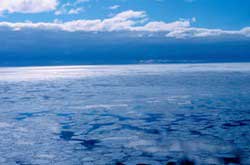Arctic ice will melt?
Global warming could melt most of the ice above the Arctic perennial ice before the end of the century, a prediction by a research group at the Institute of Climate Research. America's center is led by climate scientist David Lawrence.
 When the ice melts, they release a large amount of carbon into the air and threaten ocean currents and flood roads and houses in Canada, Alaska and Russia. The frozen soil currently accounts for about a quarter of the Arctic soil surface with the top layer believed to hold at least 30% of the carbon on the earth.
When the ice melts, they release a large amount of carbon into the air and threaten ocean currents and flood roads and houses in Canada, Alaska and Russia. The frozen soil currently accounts for about a quarter of the Arctic soil surface with the top layer believed to hold at least 30% of the carbon on the earth.
Dr. Lawrence and his colleagues used computers to measure the interaction between the atmosphere, the ocean, ice in the sea and the ice, as well as the freezing of soil. Assuming that carbon dioxide and other greenhouse gases continue to be released from motor vehicles, power plants and other sources, scientists get the result that the land has a glacier about 3.5 m thick on the Arctic surface will shrink from 4 million square miles (one mile = 1.6 km) to 1 million square miles by 2050.
By 2100, this land was only about 400,000 square miles, which would happen within a century. In August of this year, Siberian research scientists reported an unprecedented thawing phenomenon in the world's largest mudflat here, which they fear is emitting billions of tons of methane, one type. Greenhouse gas is 20 times more toxic to carbon dioxide.
Meanwhile, the US Senate has just rejected a project to allow oil exploitation in the largest reserves in the United States located below the Alaska Wildlife Protection Area. The Republic had expected this project to be approved to put the plan for oil exploitation in Alaska into the law on defense spending to determine the amounts of money for US troops in Iraq and the relief of Katrina victims.
SUPPLY
- The Arctic lost three times as much ice as Belgium every day
- Perennial ice in the Arctic is disappearing
- From now until 2080, the Arctic ice can melt completely
- Every second 14,000 tons of water flows into the sea because the Arctic ice melts
- Ice in the Arctic is likely to disappear by 2030
- Arctic will melt ice after 5 years
- 7 irreplaceable roles of the Arctic sea ice
- Abnormal melting ice alarm in the Arctic
- The Arctic temperature is the highest in 44,000 years
- Arctic melting ice could cause $ 60,000 billion in damage
- The Arctic ice sheet dropped a record
- The Arctic may run out of ice within a decade
 Is the magnetic North Pole shift dangerous to humanity?
Is the magnetic North Pole shift dangerous to humanity? Washington legalizes the recycling of human bodies into fertilizer
Washington legalizes the recycling of human bodies into fertilizer Lightning stone - the mysterious guest
Lightning stone - the mysterious guest Stunned by the mysterious sunset, strange appearance
Stunned by the mysterious sunset, strange appearance Plan to build giant canopy over Antarctica has problems
Plan to build giant canopy over Antarctica has problems  Why does ice stick to your hands when you hold it?
Why does ice stick to your hands when you hold it?  NASA releases ice map on Mars
NASA releases ice map on Mars  After 389 days in the Arctic, costing more than $160 million, hundreds of scientists brought back bad news: What was it?
After 389 days in the Arctic, costing more than $160 million, hundreds of scientists brought back bad news: What was it?  650,000-year-old 'gateway to the underworld' discovered in Siberia
650,000-year-old 'gateway to the underworld' discovered in Siberia  How to explain the strange ice circle that rotates like a time-travel door?
How to explain the strange ice circle that rotates like a time-travel door? 